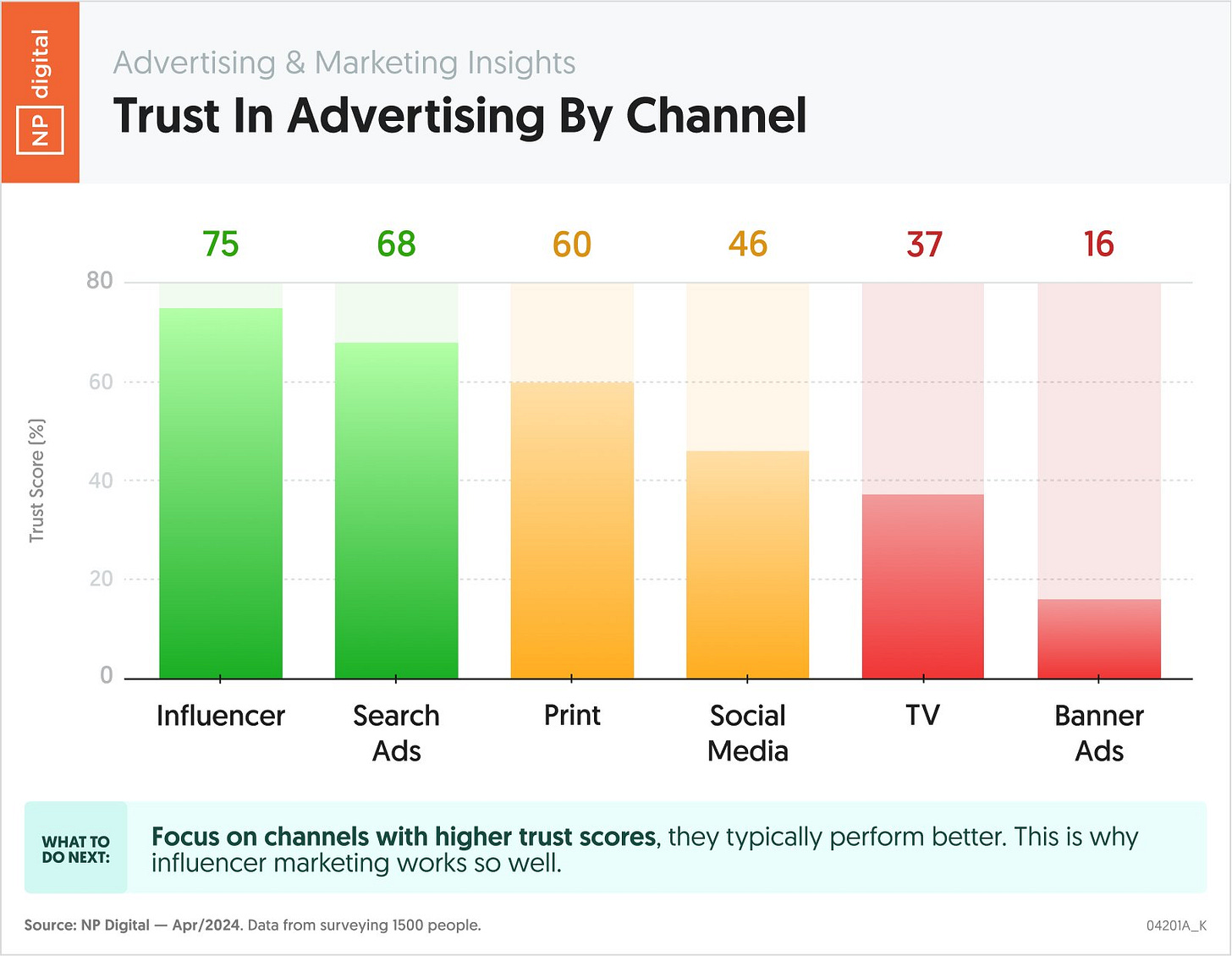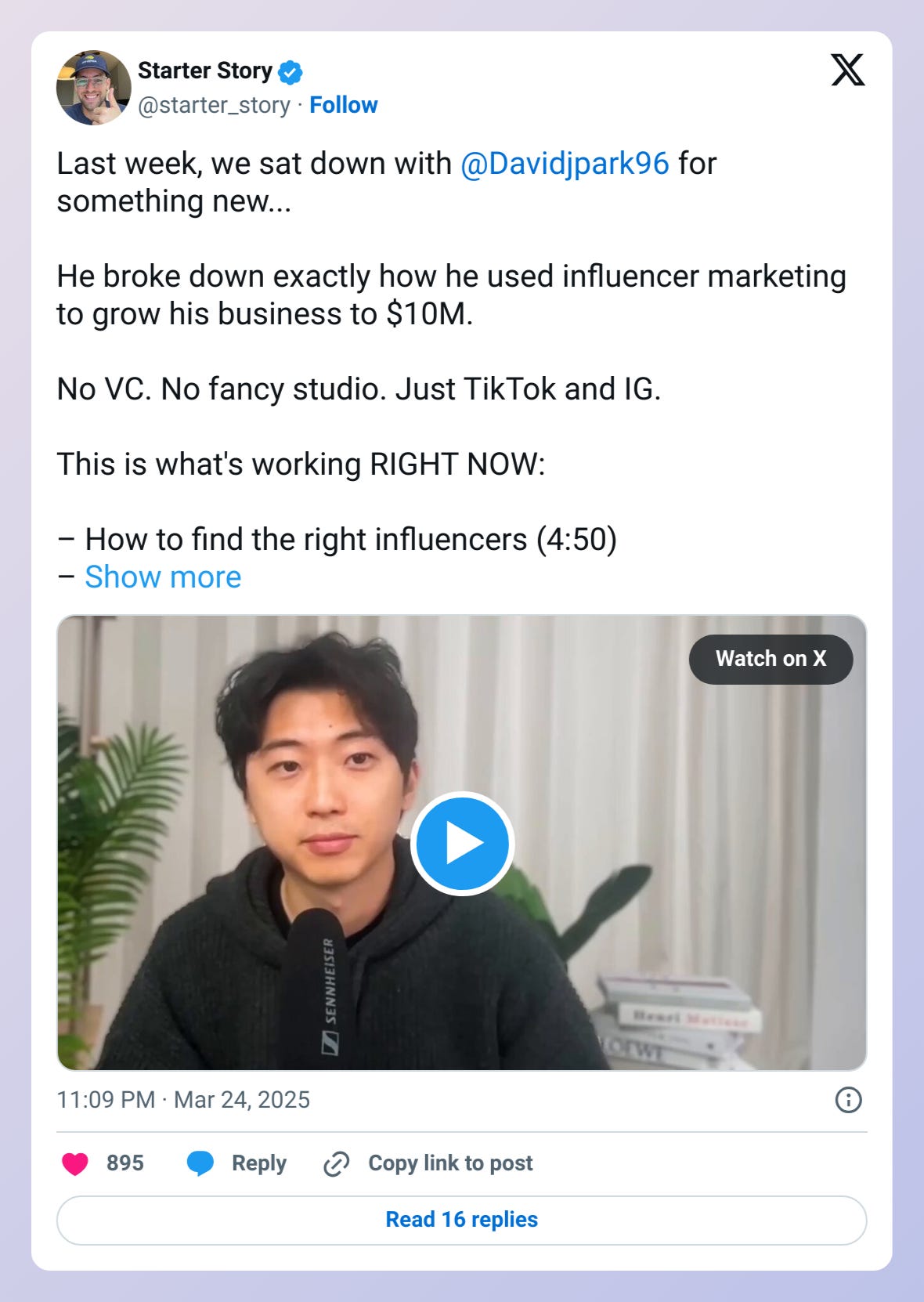The most trusted channel you’re not using right (or at all)
It’s not ads. It’s not email. And most brands are still ignoring it (or doing it wrong).
📆 Thursday, 29 May 2025
Hey — It's Rhythm. Thrilled to have you back in Ecom Circle, where I spend my time scaling ecom brands & finding best growth strategies to share with you.
DEEP DIVE 💡Do you know which channel your customers trust the most?
It’s not Meta ads.
It’s not email.
It’s definitely not that half-hearted TikTok post your intern scheduled at 3AM.
It’s other people.
Specifically: Influencers.
Yep — people trust influencers more than almost any other marketing channel out there.
Not the Kardashians. We’re talking real creators. Micro-influencers. Niche community leaders. People with a tight-knit audience who actually listen to them.
Think about it:
Would you buy a new skincare serum just because an ad says it’s “dermatologist approved”?
Or would you trust the girl on TikTok who actually used it for 30 days and showed the results — blemishes, breakouts, and all?
Right.
And that’s exactly why influencer marketing still works like crazy — if you do it right.
But here’s the kicker…
Most brands are screwing it up.
So in today’s issue, we’re diving deep into the most common influencer marketing mistakes I see eCommerce brands make — and how to avoid flushing your ad budget down the drain.
Let’s go 👇
But before that here is a quick word from today’s sponsor - Insense
Find your perfect influencers in 48hrs — who actually follow the brief!
- Insense is your all-in-one solution for UGC + influencer marketing.
- 68K+ vetted UGC creators + micro-influencers from 35+ countries
- Get matched in under 48 hours - even for niche markets
- From UGC to seeding to whitelisted ad for Meta and TikTok
Here’s where most ecommerce brands mess up influencer marketing:
1. You’re treating it like performance marketing. It’s not.
Too many marketers measure influencer campaigns like they measure Meta ads:
ROAS?
CPA?
Conversion window?
Stop.
Influencer marketing lives at the top of the funnel. Think of it as a bridge between someone never having heard of you to Googling your name because their favorite creator swears by your stuff.
That same skincare brand? I had them stop measuring sales. Instead, we tracked search volume uplift and direct traffic spikes.
Spoiler: It worked. Slowly, but surely, the content compounded and led to a 3x lift in brand keyword searches within 60 days.
Influencer marketing is a brand-building game. Not a “flip-the-switch-and-expect-ROAS” one.
2. You’re being cheap — and it shows.
I get it. Margins are tight. But if you’re offering a 10% commission and expecting creators to scream your praises into their ring lights, you’ve got it backwards.
Influencers aren’t affiliates. They’re advocates. And advocates need to be excited.
You know what we did with another DTC brand selling gourmet pet treats?
We told creators:
“Hey, we’re not Amazon. But we do believe in long-term partnerships. We’ll offer 40% rev-share and quarterly bonuses if you crush it. You in?”
Result:
Every creator went above and beyond. Custom skits. Unboxing videos with their pets. Even a mini vlog series. Because they were invested.
3. You’re not showing appreciation. And it’s killing your credibility.
Influencers are essentially your part-time remote sales team. So let me ask you:
When was the last time you thanked them?
No, seriously.
Have you ever sent a handwritten note? Or even just a “hey — that post was fire 🔥” DM?
One of our clients, a jewelry brand, sends their top-performing influencers personalized “thank you” boxes — complete with wine, a note, and sneak peeks of unreleased pieces.
Guess what? Those influencers never stop posting. They feel like insiders. Like part of the brand story.
And you don’t need a big budget to do this. You just need to care.
4. You’re wasting time on the wrong stuff.
Here’s the common trap:
80% of your time → finding influencers, emailing, following up, chasing content.
20% of your time → building actual relationships.
It should be flipped.
There are tools (like Saral or Modash) that’ll handle the grunt work:
Find influencers
Send automated emails and follow-ups
Track content performance
Manage creator relationships like a CRM
That gives you time to actually talk to influencers like humans.
Set up Zoom calls. Invite them to co-create product bundles. Ask for feedback on your site. Make them feel like partners, not assets.
5. You’re not playing the long game.
This is probably the biggest mindset shift.
The best influencer campaigns I’ve seen didn’t go viral in a week.
They were built over quarters, not days.
Like the brand that turned 3 YouTube creators into full-blown brand ambassadors — over a 9-month period.
By month 10, those 3 creators were driving 40% of new customer revenue.
Here’s the kicker: The creators weren’t even asked to post every month. They just loved the product and the brand that much.
Why? Because the brand:
Paid them fairly
Treated them like humans
Let them tell the story their way
Checked in often without micromanaging
It’s not magic. It’s just empathy and consistency.
TL;DR: Here’s your new influencer marketing playbook
✅ Stop expecting immediate ROI
✅ Pay well and share upside
✅ Say “thank you” like a real person
✅ Use tools to automate the grunt work
✅ Focus on real relationships
✅ Play the long game
Bonus Hack:
The brands crushing influencer marketing aren’t the ones with the most budget.
They’re the ones who understand creators — and treat them like allies, not ad placements.
Hope this helped.
Catch you next week,
— Rhythm
Founder, The Growth Tribe







